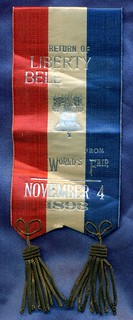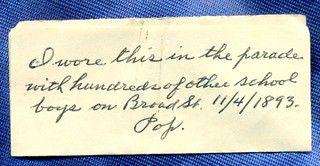
About UsThe Numismatic Bibliomania Society is a non-profit organization devoted to the study and enjoyment of numismatic literature. For more information please see our web site at coinbooks.org SubscriptionsThose wishing to become new E-Sylum subscribers (or wishing to Unsubscribe) can go to the following web page link MembershipThere is a membership application available on the web site Membership Application To join, print the application and return it with your check to the address printed on the application. Membership is only $20 to addresses in the U.S., $25 for First Class mail, and $30 elsewhere. For those without web access, write to: David M. Sundman, Treasurer
AsylumFor Asylum mailing address changes and other membership questions, contact David at this email address: dsundman@LittletonCoin.com SubmissionsTo submit items for publication in The E-Sylum, just Reply to this message, or write to the Editor at this address: whomren@gmail.com BUY THE BOOK BEFORE THE COIN |
- WAYNE'S WORDS: THE E-SYLUM OCTOBER 12, 2014
- NEW BOOK: GUIDE BOOK OF U.S. COINS, PROFESSIONAL EDITION, 6TH EDITION
- ANS OFFERS CHAZEN MUSEUM BOOK
- BOOK REVIEW: HUNNEN IN INDIEN
- SOTHEBY'S CATALOGUE DATABASE
- QUERY: JOSEPH WRIGHT 1792 PATTERN PHOTOS SOUGHT
- NOTES FROM E-SYLUM READERS: OCTOBER 12, 2014
- QUERY: IMAGES OF AMERICAN COIN TREASURES SOUGHT
- POLITICAL CAMPAIGN AND SATIRE NOTES
- GEORGE O. WALTON AND DR. CONWAY A. BOLT
- MORE ON STICKERED SILVER DOLLARS
- RIBBON FROM THE TRAVELING LIBERTY BELL
- 1792 WASHINGTON CENTS IN NEWMAN PART V
- GOLD KENNEDY HALF NUMBERS DON'T ADD UP
- JOHN LANCHESTER ON THE ORIGIN OF THE DOLLAR
- INTERVIEW WITH BERND KLUGE
- SOME MORE MODERN HOBO NICKELS
- THE STUDIO OF ALEKSEY SABUROV
- QUERY: THE COOK ISLANDS POP-UP COIN
- THE MAKING OF PORTUGAL'S ECCENTRIC COIN
- NORWAY'S NEW PIXEL BANKNOTES
- THE FUTURE OF THE BOOK: CHAPTER ONE
- THE FUTURE OF NUMISMATICS
- THE YEAR OF FIVE EMPERORS
- SELECTIONS FROM THE STACK'S BOWERS 2014 BALTIMORE SALE
- SOME RECENT COIN DESIGNS
- COUNTRIES THAT DON’T ISSUE THEIR OWN CURRENCY
- FEATURED WEB PAGE: THE COINS OF ECUADOR
Click here to access the complete archive
To comment or submit articles, reply to whomren@gmail.com
WAYNE'S WORDS: THE E-SYLUM OCTOBER 12, 2014

New subscribers this week include: David Elliott. We now have 1,778 subscribers.
This week we open with one new numismatic book, and one review. Other topics include the Joseph Wright 1792 pattern, the 1792 Washington Cents, American coin treasures and hoards, political satire notes, Aleksey Saburov, the Year of Five Emperors, and Norway's pixelated banknotes.
To learn more about coins of the Huns, the coin collection of Sir Arthur Conan Doyle, the New Math of Old Coins, Paper Money hoards, Clifford Mishler's stickered dollars, the Bode-Museum numismatic library, Fred Michaleson's 3-Legged Buffalo, Choctaw Treasury Warrants, and Hancock's Revenge, read on. Have a great week, everyone!
Wayne Homren
Editor, The E-Sylum
NEW BOOK: GUIDE BOOK OF U.S. COINS, PROFESSIONAL EDITION, 6TH EDITION
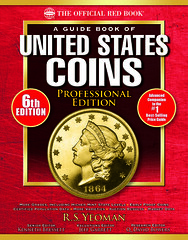 Whitman Publishing has released the sixth edition of its
expanded version of the best-selling Guide Book of United States Coins (known within the
hobby as the “Red Book”). The 384-page volume, called the Professional Edition, is intended
for intermediate and advanced collectors and investors, professional coin dealers, auctioneers, and
numismatic researchers. It is available online (including at Whitman.com), at bookstores
nationwide, and from hobby dealers and booksellers. The Professional Edition is 45% larger
than the regular-edition Red Book, at 8.5 x 11 inches, and is spiralbound for convenient reference.
It retails for $29.95.
Whitman Publishing has released the sixth edition of its
expanded version of the best-selling Guide Book of United States Coins (known within the
hobby as the “Red Book”). The 384-page volume, called the Professional Edition, is intended
for intermediate and advanced collectors and investors, professional coin dealers, auctioneers, and
numismatic researchers. It is available online (including at Whitman.com), at bookstores
nationwide, and from hobby dealers and booksellers. The Professional Edition is 45% larger
than the regular-edition Red Book, at 8.5 x 11 inches, and is spiralbound for convenient reference.
It retails for $29.95.
Updates in the sixth edition include:
- A new illustrated appendix on coin cleaning, conservation, and preservation
- Current market prices in high circulated grades and multiple Mint State and Proof grades
- Recent auction records from 2013 and 2014
- Updated and additional coin photographs
- New historical illustrations in the coin-denomination essays
- Updated “Recommended Reading” lists
- Whitman Publishing coupons, in the back of the book, worth $23.80
Standard features of the Professional Edition that go beyond the regular-edition Red Book include:
- Detailed coverage of every federal coin type, half cents through double eagles, plus classic commemoratives, Proof and Mint sets, and bullion coins.
- Expanded valuations, including multiple Mint State and Proof levels, plus Full Steps, Full Bands, Full Head, Full Bell Lines, Cameo / Deep Cameo, and other specialized designations.
- Certified-coin population summaries (PCGS and NGC) for every date and mintmark—including the number certified, the average grade, the percent in Mint State, and the finest Proof.
- Recent auction data for coins listed.
- Additional die varieties in every denomination, with close-up photographs for easy identification.
- More than 1,600 high-quality, full-color photographs of Mint State and Proof coins, for every type.
- Detailed research, estimated mintages, and market information on early 1800s–early 1900s Proof coinage, including gold.
- Expert guidance on striking and sharpness characteristics for each type—valuable information when comparing coins for purchase.
- Insight on availability and condition rarity for each type.
- Detailed grading instructions, including for Mint State and Proof coins.
- Informative chart notes that expand on the history, characteristics, and market values of significant coins.
- Enlargements of key focal points and variety diagnostics—many more than in the regular edition.
- A detailed section on the U.S. Mint’s silver, gold, and platinum bullion coins.
- An appendix on “Great Collectors and Collections of the Past.”
The Professional Edition’s editorial team consists of Senior Editor Kenneth Bressett, Research Editor Q. David Bowers, and Valuations Editor Jeff Garrett. Dozens of other hobby leaders contributed their expertise to the book’s production.
“The Professional Edition Red Book is not just for investors and professional numismatists,” said Whitman publisher Dennis Tucker. “Every collector who has advanced beyond the foundation of the regular-edition Red Book will find it to be an invaluable tool for building a collection. As a single-source reference book there’s nothing else like it in the hobby.”
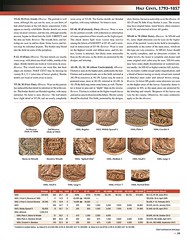
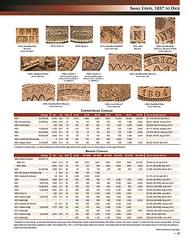
A Guide Book of United States Coins, Professional Edition, sixth edition Senior editor Kenneth Bressett; research editor Q. David Bowers; valuations editor Jeff Garrett.
ISBN 0794842194
384 pages, full color.
8.5 x 11 inches, spiralbound softcover.
Retail $29.95
For more information, or to order, see:
www.whitman.com

ANS OFFERS CHAZEN MUSEUM BOOK
European Medals in the Chazen Museum of Art
Highlights from the Vernon Hall Collection and Later Acquisitions
Introductory Essay by Stephen K. Scher
Contributors: Philip Attwood, Arne R. Flaten, Mark Jones, Douglas Lewis, Eleonora Luciano, Joseph
G. Reinis, Stephen K. Scher, Jeffrey Chipps Smith, Louis A. Waldman
Edited by Maria F.P. Saffiotti Dale
Softcover, illus.
SBN: 978-1-93327-017-3
List price: $39.95 (plus S&H)
Member price: $27.97 (plus S&H)
Chazen Museum of Art, University of Wisconsin-Madison American Numismatic Society 2014
This grouping of medals represents the museum’s Renaissance, Baroque, and nineteenth-century highlights and illustrates the history of the art of the commemorative medal. This catalogue incorporates the scholarship of nine international medallic experts. Their erudition, consummate research skills, and effective prose are evident in sixty-one essays on some of the masterpieces of this art form written for the education and enjoyment of students, specialists, and the general public alike.
For more information, or to order, see:
European Medals in the Chazen Museum of
Art (numismatics.org/Store/ChazenEuroMedals)
To read the earlier E-Sylum article, see:
NEW BOOK: EUROPEAN MEDALS IN THE CHAZEN
MUSEUM (www.coinbooks.org/esylum_v17n41a05.html)
BOOK REVIEW: HUNNEN IN INDIEN
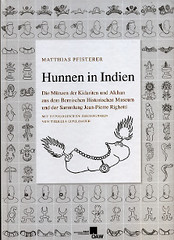 Matthias Pfisterer, Hunnen in Indien. Die Münzen der
Kidariten und Alchan aus dem Bernischen Historischen Museum und der Sammlung Jean-Pierrre Righetti.
Mit typologischen Zeichnungen von Theresa Eipeldauer. Verlag der Österreichischen Akademie der
Wissenschaften, Vienna, 2013. 30.2 x 22.2cm, 335 pp. images in b/w. Hardcover. ISBN:
978-3-7001-7372-4. Price: 89 euros.
Matthias Pfisterer, Hunnen in Indien. Die Münzen der
Kidariten und Alchan aus dem Bernischen Historischen Museum und der Sammlung Jean-Pierrre Righetti.
Mit typologischen Zeichnungen von Theresa Eipeldauer. Verlag der Österreichischen Akademie der
Wissenschaften, Vienna, 2013. 30.2 x 22.2cm, 335 pp. images in b/w. Hardcover. ISBN:
978-3-7001-7372-4. Price: 89 euros.
On hearing the word “Huns”, even historians won’t be able to come up with much more than the name “Attila”. Only very few people are aware of the fact that further Hunnish kingdoms existed in the border area between Iran, Central Asia and India. The knowledge that coin collectors and numismatists have of the Kidarite kingdom or that of the Alchan is equally limited. This is evident when looking at the fact that similar coins which originated in these kingdoms are often described in auction and collection catalogues very differently, depending on the state of research reflected in the reference work that was available to the catalogues’ editors at the time of publication.
So you keep hoping for a new work of reference that will once and for all end this catalogue madness. Now Matthias Pfisterer has paved the way. In revising the catalogues of the collection at the Historical Museum in Bern (Switzerland) and that of private collector Jean-Pierre Righetti, Pfisterer not only consulted these two collections, but many others: in Islamabad, New York, Toyko and many more places, as the book’s acknowledgment indicate.
The greatly widened scope of available material provides a real treasure and enables new insights in this field of numismatic research, which currently enjoys great popularity. In 2010 for instance, Joe Cribb published his seminal paper on the Kidarites (Joe Cribb, The Kidarites, the Numismatic Evidence. With an Analytical Appendix by A. Oddy, in: Coins, Art and Chronology II – The first millennium C.E. in the Indo-Iranian borderlands. Wien 2010), so that the author of “Hunnen in Indien” (“Huns in India”) could afford to limit the respective chapter to a five-page summary.
His study on Alchan coinage, on the other hand, comprises some 170 pages and, due to the much increased quantity of material today, far exceeds the scientific scope of Robert Göbl’s four-volume publication “Dokumente zur Geschichte der iranischen Hunnen in Baktrien und Indien” from 1967.
Mind you, Matthias Pfisterer lays no claims to rewriting the history of the forgotten Alchan people. He successfully limits himself to describing the Alchan coin history, including a reconstruction of the structure and system of Alchan coinage, in as much detail as possible. The publication, written according to the Viennese system (“Wiener Aufbau”), is difficult to read but provides a valuable starting point for further research. For that reason, the text addresses only an extremely limited audience. Almost everyone consulting it prior to the publication of a catalogue will immediately jump to page 207, where the collection catalogue Bern/ Righetti begins.
To read the complete article, see:
Huns in India
(www.coinsweekly.com/en/News/4?&id=3056)
SOTHEBY’S CATALOGUE DATABASE
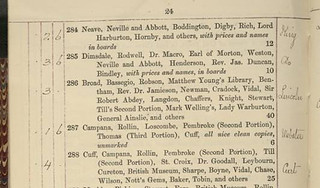 The coin cabinet of the Royal Library of Belgium is most
fortunate to possess the coin collection and the library of Lucien de Hirsch, given to the Belgian
state by his mother in 1899. Among the treasures of his library one finds a full set of 409
catalogues produced by Sotheby’s for the years 1833-1869.
The coin cabinet of the Royal Library of Belgium is most
fortunate to possess the coin collection and the library of Lucien de Hirsch, given to the Belgian
state by his mother in 1899. Among the treasures of his library one finds a full set of 409
catalogues produced by Sotheby’s for the years 1833-1869.
These catalogues, which once belonged to Benjamin Nightingale and then to Charles Richard Taylor, have all been annotated with for each coin the realized price and the name of the buyer. This is of crucial evidence to rebuild the vibrant network of coin collectors, dealers and auctioneers active in London at that time.
About 900 names have been recorded and are now listed on the website of the Brussels coin cabinet which may be consulted online.
To visit the Brussels coin cabinet website, see:
Les
collectionneurs londoniens de monnaies et de médailles
(www.kbr.be/collections/medailles/dossiers/collectionneursLondoniens_fr.html)
To read the complete article, see:
New online database for Sotheby’s
catalogues (www.coinsweekly.com/en/News/4?&id=3054)
THE BOOK BAZARRE
QUERY: JOSEPH WRIGHT 1792 PATTERN PHOTOS SOUGHT
Tom DeLorey writes:
Dave Bowers' request concerning the 1794 starred reverse cent seems to be missing something. He seems to be asking about some piece in Judd, and not the starred reverse cent, which is not in Judd.
Pete Smith also caught this. He writes:
The headline indicates that QDB is looking for photos of the starred reverse. Such photos are quite easy to find.
It appears to me that QDB is looking for something else. Is the "Wright Quarter" what he wants?
Dave writes:
Yes - I had meant to ask for pictures of the Joseph Wright 1792 pattern with eagle on globe so I could compare the stars with the 1794 S-48.
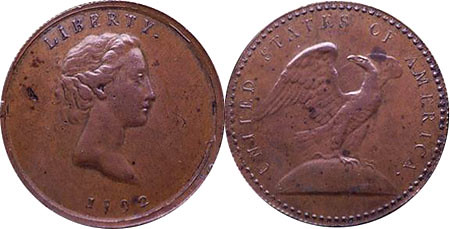
Pete Smith adds:
Attached is a picture of the "Wright Quarter". However, the quality is not good enough to compare the stars with those on the starred reverse.
In 1986 I looked at a Wright Quarter in the Smithsonian and determined that the stars were from different punches.
David McCarthy wrote an article where he claimed they were from the same punches.
Dave Bowers adds:
My theory (subject to change): A reverse die with 94 tiny five-pointed stars oriented outward (instead of inward as on the 1792 pattern) was on hand, and rather than waste it, elements of S-48 (1794 Starred Reverse) were punched over it. That the stars were not added or intentional on the 1794, but were leftover, seems to be borne out by their being overcut with dentils.
To read the earlier E-Sylum article, see:
NOTES FROM E-SYLUM READERS: OCTOBER 5,
2014 : Query: 1794 Starred Reverse Cent Photos Sought
(ww.coinbooks.org/esylum_v17n41a12.html)
NOTES FROM E-SYLUM READERS: OCTOBER 12, 2014
Query: Coins Pedigreed to Sir Arthur Conan Doyle Sought
Gene Anderson writes:
The Fourth Garrideb (the coin club focusing on numismatics related to Sherlock Holmes) is trying to trace the coin collection of Sir Arthur Conan Doyle. We would be interested in hearing from anyone who has a copy of the Fall 1968 price list of Manfra, Tordella, & Brookes or anyone who owns a coin pedigreed to Doyle.
For more information on The Fourth Garrideb, see:
http://fourthgarrideb.com
Query: Information About William A. Wahler Sought
Arnold Tescher writes:
I am searching for bibliographic information about William A. Wahler, a coin collector who died in 1988 and was said to have formed the most complete collection of ancient Greek Hellenistic portrait coins in private hands at the time. Please send to Arnold Tescher at athistory@aol.com. Thank you.
Subscriber Number 1776: John Hart
Ray Williams writes:
Assuming that you list the new subscribers in the order they subscribe, how cool is it that member 1776 is named John Hart - the same name as a New Jersey Signer of the Declaration of Independence!!!
To read the earlier E-Sylum article, see:
WAYNE'S WORDS: THE E-SYLUM OCTOBER 5,
2014 (www.coinbooks.org/esylum_v17n41a01.html)
The New Math of Old Coins
Leon Saryan writes:
if the coins were struck in 400 AD how can they be 2000 years old? New math???
To read the complete article, see:
Man sleeps in car for 3 days protecting 'remarkable' treasure
/www.aol.com/article/2014/10/02/man-sleeps-in-car-for-3-days-protecting-remarkable-treasure/20971343/)
To read the earlier E-Sylum article, see:
THE SEATON DOWN HOARD OF 22,000 ROMAN
COINS (www.coinbooks.org/esylum_v17n40a29.html)
The Burger King Five Dollar Bill
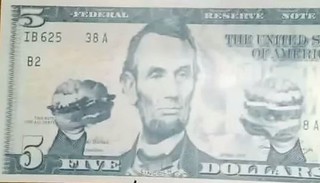 Justin Perrault writes:
Justin Perrault writes:
In keeping with our numismatically-themed fast food commercials, here is another one from Burger King, this time for paper money collectors.
To view the video, see:
https://www.youtube.com/watch?v=LxglxCs5qSI
A First National Bank of Boston Coin Set in Lucite
George Kolbe writes:
For whatever it’s worth, I have a Lucite (not quite a) cube, given to me several years ago by a friend, with the following impressed in white on one side (in reverse, readable when viewed through its opposing side):
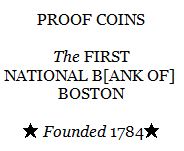
The encased coins comprise a 1956 proof set. The text within brackets has been largely rubbed off over the years.
To read the earlier E-Sylum article, see:
NOTES FROM E-SYLUM READERS: OCTOBER 5,
2014 : 50 Years of Coins in Lucite (www.coinbooks.org/esylum_v17n41a12.html)
QUERY: IMAGES OF AMERICAN COIN TREASURES SOUGHT
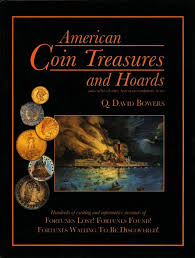 For eighteen years I have been creating the
text for a book that I will be delivering to Whitman Publishing Ltd. within the next several weeks.
The working title is American Coin Treasures and Hoards, Volume 2. This is my first detailed
announcement of it. The book will be released nationwide by Whitman in 2015.
For eighteen years I have been creating the
text for a book that I will be delivering to Whitman Publishing Ltd. within the next several weeks.
The working title is American Coin Treasures and Hoards, Volume 2. This is my first detailed
announcement of it. The book will be released nationwide by Whitman in 2015.
It was in 1997 that I started a folder, Treasure Book II. Since then I have added hundreds of articles, clippings, news reports, and more. Back in 1997 the S.S. Central America treasure was known, but its contents were kept a deep secret. The S.S. Brother Jonathan treasure, unknown then, is chronicled now. The Odyssey Marine Exploration discovery in 2003 of the S.S. Republic, with over 10,000 gold and silver coins, was not dreamed of then (Odyssey has been of great help, including with the ongoing exploration of the Central America).
Other finds at sea have been revealed as have many on land, including the Saddle Ridge Hoard. With a great deal of help from many directions, the new book is nearly complete. It will be quality hardbound, mostly illustrated in color (19th century engravings excepted!), and will have much information ever before in print in any single book.
I have a “want list” of images—desired in color and of 400 dpi or higher. Your reward will be a credit in the book. First, here is the table of contents:
- Preface by Kenneth E. Bressett
- Foreword by Bob Evans
- Introduction by the Author
- Chapter 1: Finds of Colonial and Early Coins
- Chapter 2: Coins Hidden Here and There
- Chapter 3: Hoarders and Misers
- Chapter 4: Dealer and Collector Hoards
- Chapter 5: Hoards of Old Copper Cents
- Chapter 6: Hoards of Small Cents
- Chapter 7: The Incredible Economite Hoard
- Chapter 8: Silver Coins from Various Places
- Chapter 9: Silver Coins Go to Foreign Lands
- Chapter 10: Gold Is Where You Find It
- Chapter 11: Down with the Ship
- Chapter 12: Gold Rush Treasure: S.S. Winfield Scott
- Chapter 13: Gold Rush Treasure: S.S. Yankee Blade
- Chapter 14: Gold Rush Treasure: S.S. Central America
- Chapter 15: The Fate of the S.S. Brother Jonathan
- Chapter 16: The S.S. Republic Treasure
- Chapter 17: Hoards of Commemorative Coins
- Chapter 18: The Great Treasury Hoard of Silver Dollars
- Chapter 19: U.S. Gold Coins Found in Foreign Countries
- Chapter 20: Secrets of the Philadelphia Mint
- Chapter 21: Notable Single-Coin Finds
- Chapter 22: Undiscovered Treasures on Land
- Chapter 23: Undiscovered Treasures in the Sea
- Chapter 24: Treasure Hunting Electronic Style
- Chapter 25: Paper Money Hoards
- Chapter 26: Hoaxes, Fantasies, and Questioned Finds
“Want List” of Images of American Coins and Scenes
I seek items specifically pedigreed to having been found from these sources:
- S.S. Lexington (1840) Coins plus any sketches or images of the ship.
- S.S. North Carolina (1840) Coins plus any sketches or images of the ship.
- S.S. Winfield Scott (1853). Small-denomination California gold.
- S.S. Yankee Blade (1854) 1854-S $20 Mint State but with lighted etched surfaces. Plus sketches or images of the ship.
- Any other ship except the S.S. New York, Brother Jonathan, Central America, and Republic.
- Information and, if available, images, regarding any significant hoards of coins, tokens, medals, or paper money lost or hidden before 1940 and discovered 1996 to date.
- Several images of copper and silver coins from Christie’s sale of the Lord St. Oswald Collection in London in 1964.
- Any images of rare coins found by treasure detectorists.
- Paper money: Notes from these finds: First National Bank of Davenport (IA) hoard, Oat Bin hoard, Ella Overby hoard, 1971 Carrollton (TX) find of Gold Certificates, Esterville (IA) $50 and $100 rarities, Wood River hoard, 2005 hoard of paper money found in Massachusetts.
I appreciate any help received.
Happy Columbus Day
Dave Bowers
Box 539
Wolfeboro Falls, NH 03896
qdbarchive@metrocast.net

POLITICAL CAMPAIGN AND SATIRE NOTES

With the November mid-term elections just around the corner most of you are no doubt weary of the seemingly endless barrage of campaign ads on TV, radio, social media and elsewhere. The constant in your face approach of politicians and their backers is nothing new. Over the years candidates and political parties have even turned to paper money (or notes made to appear as money), in order to sway the opinion of the voting public.
This practice goes back at least to the mid-1800s and continues today. William J. Curry employed a rather crudely executed $100 "bill" in his 1950 campaign for Ohio's 10th Congressional District seat. The note promoted Curry's platform of establishing a $100 per month pension for persons over 60 years of age. Curry lost the election to long term Congressman Thomas A. Jenkins.
A depression era campaign note by the Washington Taxpayer's Council promoted candidates running for office in Seattle by drawing on the popularity of then President Franklin D. Roosevelt to attract voters. Roosevelt is pictured on their note, which touts tax reductions for the citizens of Seattle. The back lists candidates for office that citizens are encouraged to vote for.
Not all political notes endorse candidates for office. Some are used for political satire and attack politicians or policies. President Richard Nixon was a popular target of satire notes that attacked his Cold War policies and highlighted inflation which plagued the nation at the time.
Satire notes are still around today and make fun of candidates from all parties. Campaign advertising notes are not seen with any regularity today, as candidates have turned to more advanced (and annoying) methods to get their messages out to the masses. There's just under a month to go until election day and no doubt the ads will be flying for just a bit more.
I'm Brad Ciociola and I approve this message. No public funds were used for the writing of this blog.
To read the complete article, see:
Political Campaign and Satire Notes (www.stacksbowers.com/NewsMedia/Blogs/TabId/780/ArtMID/
2678/ArticleID/64789/Political-Campaign-and-Satire-Notes.aspx)
GEORGE O. WALTON AND DR. CONWAY A. BOLT
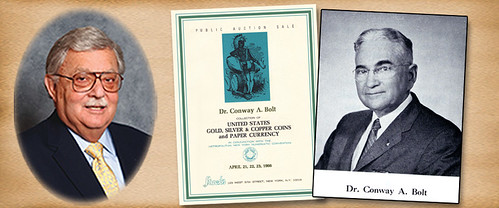
For Part 4 of my series on Dr. Conway A. Bolt, I will begin to focus on some different areas of his collection, including his exciting cabinet of pioneer and territorial gold coins of America and also his collection of early bank notes from before federal paper money was issued.
Both of these series were collected as a result of Dr. Bolt’s interest in the histories of the companies that issued them, their importance to the advancement of commerce and their contribution to our national heritage. As the good doctor lived in the Mid-Atlantic States, the issues by Bechtler in both Carolina and Georgia were appealing to him for the part they played in history of that area. He visited the museums where Bechtler coins were shown, and met the curators who explained to him the development of the Bechtler coinage, made from the gold found in the Carolina and Georgia areas. Some of the history of the banking and commerce of these southern states could be told by the gold coins, (and of course the bank notes) which were issued in the area.
Also adding to the information he gained was his great friendship with George O. Walton, (see earlier in this column for more information on Walton) who was a bank examiner and also worked for the Federal Government in the mid-Atlantic area. Dr. Bolt learned a lot from George and gained from the knowledge the latter gentleman had gained in his working and collecting. Mr. Walton collected, bought and sold coins and currency to collectors as he passed from town to town (over the hills and valleys as he used to tell it), and gathered together gold coins, antiques, and anything that was of interest to him. When he visited Dr. Bolt, they shared the stories each had heard, traded coins and currency and became profoundly interested in the monetary history of this pre-Civil War period.
First I will review the extent of George Walton’s and Dr. Bolt's Bechtler coinage. While going through the hoard that George O. Walton left, Norman Stack and I discovered some 27 different examples of Carolina and Bechtler coinage. In the Walton catalog we wrote a list and description of each variety and we gave them "S" numbers for "Stack's" as this was the first time all were listed and described. We consulted with Dr. Bolt and he reported that the varieties we found of the Bechtler coinage, as of the time he worked with Walton on the collecting this issue, were all that were known at that time.
A review of the Bolt Collection showed us among his 29 specimens, he lacked two that Walton had but had one that Walton did not have. So the S -27 became a new variety which was an A.BECHTLER 1.00 GOLD, 27 G. 21 C., which had a unique reeded edge, instead of a plain edge as on the Walton coins. It was a "find" for Norman and me and became listed as such. Working on two important collections of a series gave us the opportunity to examine all the coins carefully and discover the varieties. It is extra exciting for a cataloger to discover something new!
Dr. Bolt had other pioneer coins within his collection and I will continue to describe them in the next part of my story of this amazing collection. I will also tell of the U.S. patterns he assembled and the federal paper money he possessed. This story has been a reminder of what a fine collection this was, the fun I had working on it and the great knowledge I gained. This was true whenever I and others had the enviable task of producing an informative and attractive catalog.
To read the complete article, see:
Stack’s Sells the Dr. Conway A. Bolt Collection in 1966, Part 4
(www.stacksbowers.com/NewsMedia/Blogs/TabId/780/ArtMID/
2678/ArticleID/64778/Stack%E2%80%99s-Sells-the-Dr-Conway-A-Bolt-Collection-in-1966-Part-4.aspx)
MORE ON STICKERED SILVER DOLLARS
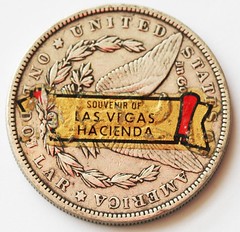 I have an accumulation that is well in excess of 700
stickered silver dollars by individual issuers. I also have fair accumulations of stickered
offerings on other denominations. While I am aware of others who collect this genre by state, I am
not aware of anyone who seeks them without restriction.
I have an accumulation that is well in excess of 700
stickered silver dollars by individual issuers. I also have fair accumulations of stickered
offerings on other denominations. While I am aware of others who collect this genre by state, I am
not aware of anyone who seeks them without restriction.
At this point I do have my collection organized alphabetically by issuer, but I have yet to set myself to the task of preparing a catalog of the collection, which could then be enhanced by the incorporation of the holdings of others. I’m always of a mind to get to that someday! When that someday will be, I have not the slightest idea.
While stickered dollars and other denominational issues are certainly not rare from a value standpoint, I believe that I have never encountered a second example of at least two-thirds of the pieces held in my collection. Thus, most issues are certainly scarce. Relatively few issues, perhaps in the 15 to 20 range might be considered to be commonly encountered. My favorite pieces are the trade stimulator and payroll offerings which are relatively few in number. The vast majority of issues are trade card and chamber style promotional pieces.
To read the earlier E-Sylum articles, see:
COAL DOLLARS
(www.coinbooks.org/esylum_v17n40a20.html)
MORE STICKERED COINS
(www.coinbooks.org/esylum_v17n40a21.html)

Archives International Auctions, Part XXI
4th Annual Wall Street Coin, Currency & Collectible Show Auction
Federal Fiscal Documents & Security Printing Ephemera
Highlights include:
- Lot 759 Palestine Currency Board, 1929 High Grade Issue
- Lot 1053 British American Bank Note Company Engravers & Printers
- Lot 400 Richmond and Petersburg Rail Road Company, 1870 Specimen Bond
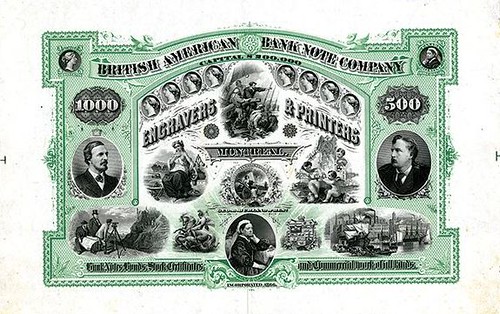
1580 Lemoine Avenue, Suite #7
Fort Lee, NJ 07024
Phone: 201-944-4800
Email: info@archivesinternational.com
WWW.ARCHIVESINTERNATIONAL.COM
RIBBON FROM THE TRAVELING LIBERTY BELL
Russ Sears writes:
Some time ago there was discussion about the Liberty Bell traveling to expositions around the country. Recently I acquired the pictured ribbon which was issued for the return of the bell in 1893 from the Columbian Exposition. The note was with it.
To read the earlier E-Sylum article, see:
NOTES FROM E-SYLUM READERS: JANUARY 27,
2013 : The Traveling Liberty Bell (www.coinbooks.org/esylum_v16n04a08.html)
1792 WASHINGTON CENTS IN NEWMAN PART V
1792 Washington President Cent
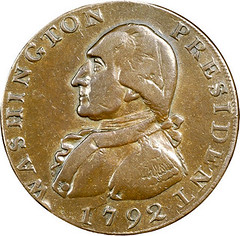
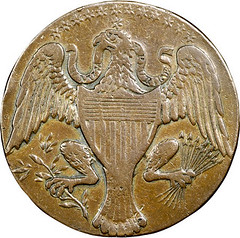
1792 Washington President Cent, Eagle and Stars Reverse. T Below Bust. Lettered Edge. XF40 NGC. Baker-21B, Breen-1228, 1995 COAC WA.1792.5, W-10685, Unique. 175.4 grains, 99% copper per NGC metallurgical tests. There are two major types of the Washington President cents distinguished by their reverses, featuring either an eagle and 13 stars or the General of the American Armies. Many subscribe to the traditional viewpoint that these pieces are closely related to the 1791 Large Eagle and Small Eagle cents; they are typically attributed to the same engraver, John Gregory Hancock, Jr. Described as a child prodigy, Hancock was employed by Obadiah Westwood’s private mint in Birmingham, England. George Fuld explains in his 1995 ANS Coinage of the America’s Conference article “Coinage Featuring George Washington:”
“Although no direct evidence exists as to the origin of this series, die punch linkage and style directly link the 1792 British issues to J.G. Hancock and Westwood’s Mint. Clearly they must have been manufactured between the time of the 1792 cents and before knowledge of rejection of monarchical portraits by Congress [March 1792]. Breen conjectures that for the eagle reverse with no denomination, the strikings in copper, silver and gold represented cent, half dollar and ten dollar samples, while Newman believes the gold and silver specimens were too different from any circulating coin to be usable.”
However, evidence suggests that these pieces and the related Washington Born Virginia coppers were made on the American shore, specifically at the oceanside town of Newburyport, Massachusetts.
In "Perkins and the Washington Medal," published in the August 2010 issue of The Numismatist, John J. Kraljevich, Jr. presents compelling evidence that a talented young American engraver, Jacob Perkins, was the author of these 1792 Washington pieces.
To view the complete auction lot description, see:
1792 Washington President Cent
(coins.ha.com/itm/colonials/1792-cent-washington-president-cent-eagle-and-stars-reverse-t-below-bust-lettered-edge-xf40-ngc-cac-baker-21b-breen-12/a/1215-3031.s?ic3=ViewItem-Auction-Open-NextLot-081514)
1792 Washington President Plain Edge Cent, General of the Armies Reverse
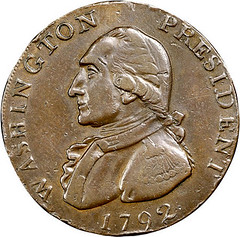
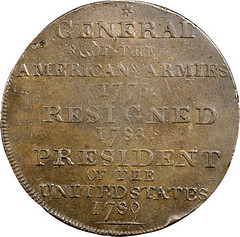
1792 Washington President Cent, General of the Armies Reverse, Plain Edge XF45 NGC. Baker-59, Breen-1234, 1995 COAC WA.1792.6, W-10690, R.6. 181.9 grains, 99% copper per NGC metallurgical tests. As noted in the previous lot, compelling evidence places the production of the 1792 Washington President cents at Newburyport, Massachusetts, from the hand of a talented young engraver named Jacob Perkins. However, others including Eric P. Newman hold the traditional numismatic viewpoint that these pieces were coined at Westwood’s private mint in Birmingham. The Washington Born Virginia obverse die was in the possession of the Perkins family until at least the late 19th century. One of the three varieties of Washington Born Virginia coppers shares the same reverse as this variety, and a second variety with that obverse shares the same reverse of the example in the previous lot. All of these pieces were clearly made by the same hand. Until John Kraljevich presented his compelling evidence, everyone believed these pieces were made in England.
As truly American productions, the Washington President and Washington Born Virginia coppers are elevated to their rightful place among the most important pieces in the Early American field, equally as important as the Getz patterns. With an estimated population at fewer than 30 pieces, these coppers are even rarer than those made by Getz, and they should be considered every bit as valuable, if not more so.
To view the complete auction lot description, see:
1792 CENT Washington President Cent, General of the Armies Reverse
(coins.ha.com/itm/colonials/1792-cent-washington-president-cent-general-of-the-armies-reverse-plain-edge-xf45-ngc-cac-baker-59-breen-1234-1995-coac/a/1215-3032.s)
1792 Baker-25 Washington President Cent

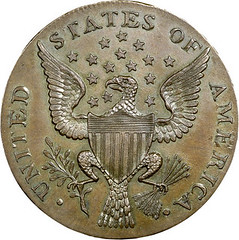
1792 Getz Washington President Pattern Cent, Plain Edge MS64 Brown NGC. Baker-25, Breen-1352, Pollock-5020, W-10775, R.5. Ex: "Col." E.H.R. Green. 257.7 grains, 99% copper per NGC metallurgical tests. The late Jack Collins spent many years studying the Getz silver and copper Washington President pieces. Unfortunately, he passed away before the study was completed. His friend, George Fuld, continued the study through completion, and in 2009 The Washington Pattern Coinage of Peter Getz was published by George Frederick Kolbe and Alan Meghrig.
The Peter Getz pattern coins were minted in silver and copper. Those struck in silver include 14 with a plain edge, five with the Circles and Squares edge, and three with the twin olive leaves edge. Copper impressions include 45 with a plain edge and 11 with the Circles and Squares edge. Among those 56 copper pieces are eight examples that are described as Mint State. The Eric P. Newman coin is the fifth finest of those eight pieces. An arcing planchet cutter mark is visible from the bottom of the 1 to the top of the G, continuing to the border over the A. The entire obverse is double struck, with less noticeable reverse doubling. The surfaces are prooflike, and the design motifs are bold. Both sides have attractive chocolate-brown surfaces with delicate light green toning highlights. An exceptional Getz copper.
There were many Washington pieces made as tribute pieces in England, but those by Getz were actually made in the U.S., and are considered pattern coins as opposed to Washington pattern issues. While they were made outside the mint, they were struck in Philadelphia on a coin press that was soon moved to the new Philadelphia Mint. It is our opinion that these pieces should be collected as part of the United States pattern series, and they are listed in Andrew Pollock's pattern reference.
These pattern coins are attributed to Peter Getz of Lancaster, Pennsylvania, apparently on the strength of remarks made by J. Franklin Reigart of that town, and published by Montroville Wilson Dickeson in The American Numismatical Manual:
"Mr. Getz was personally complimented by Washington for his artistic skill in producing the die for what is called the 'Washington Cent,' and it was also officially recognized by the Government. This letter was often exhibited by Major John Getz, a son of the artist, during his lifetime. Memory must, however, supply the place of this documentary proof, as it cannot now be found."
To view the complete auction lot description, see:
1792 Washington President Cent
(coins.ha.com/itm/colonials/1792-cent-getz-washington-president-pattern-cent-plain-edge-ms64-brown-ngc-baker-25-breen-1352-pollock-5020-w-10775-r5/a/1215-3034.s#1176111761190)
1792 Roman Head Cent
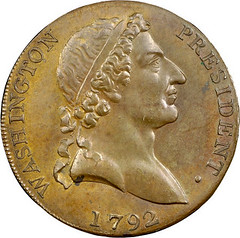
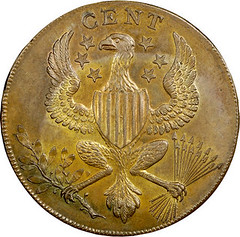
1792 Washington Roman Head Cent PR65 Red and Brown NGC. Baker-19, Breen-1249, W-10840, R.6. 197.5 grains, 99% copper per NGC metallurgical tests. The edge is lettered UNITED STATES OF AMERICA. A product of Obediah Westwood's Birmingham Mint, the dies of the Roman Head cent are attributed to the talented young engraver John Gregory Hancock. Walter Breen gave Hancock's life dates as 1775-1815 in his Complete Encyclopedia and described him as a "juvenile engraving prodigy." However, Forrer's Biographical Dictionary of Medalists suggests that those dates were his active years of engraving: "Medallist and die-sinker of the latter part of the eighteenth century and first two decades of the nineteenth, circ. 1775-1815." His son, also John Gregory Hancock (born 1791) was described as a prodigy who was engraving tokens at the age of eight or nine years. If the elder Hancock was born in 1775, he was just 16 years old when his son was born. Birmingham records indicate that John Gregory Hancock and Sarah Ward were married in 1780, suggesting that the elder engraver was likely born a couple of decades earlier, perhaps around 1760.
It is known that President Washington objected to the appearance of his likeness on the Federal coinage. However, the Senate version of the Mint Act called for "an impression or representation of the head of the president of the United States." The House of Representatives, apparently ceding to Washington's wishes, changed the wording to call for "an impression emblematic of liberty." As the Getz pattern followed the designs of Hancock's earlier Washington cents, this piece appeared as a response, although opinions of its purpose differ. In the Whitman Encyclopedia of Colonial and Early American Coins, Q. David Bowers wrote:
"The Roman Head cent depicts Washington dressed in the style of a Roman official, a popular way of honoring him, at least in memory, but these are dated during his life. The apotheosis of Washington saw many forms, most famously in Horatio Greenough's statue of epic proportions showing Washington as a Roman emperor seated on a throne. For years this was displayed on the U.S. Capitol grounds. There are many versions of similar tributes in the classic style to be found on bank note vignettes."
"When news of Washington's rejection reached Birmingham, John Gregory Hancock (doubtless with Westwood's gleeful consent, possibly at his instigation) undertook an extraordinary piece of revenge. As Washington's spokesmen had compared the idea of presidential portraits on coins to the practices of Nero, Caligula, and Cromwell, so Hancock's (and/or Westwood's) idea was to portray Washington on a coin as a degenerate, effeminate Roman emperor. Hancock's satirical masterpieces, the 'Roman Head' cents manage to convey this impression--with a subtle resemblance. ... Beginning as tokens of incredible spite, these cents have become among the most highly coveted of Washington items."
To view the complete auction lot description, see:
1792 CENT Washington Roman Head Cent
(coins.ha.com/itm/colonials/1792-cent-washington-roman-head-cent-pr65-red-and-brown-ngc-cac-baker-19-breen-1249-w-10840-r6/a/1215-3035.s)
To read the earlier E-Sylum articles, see:
NEWMAN CHALMERS THREEPENCE, SIXPENCE AND
RINGS (www.coinbooks.org/esylum_v17n39a24.html)
MORE COLONIAL SELECTIONS FROM NEWMAN PART
V (www.coinbooks.org/esylum_v17n41a17.html)
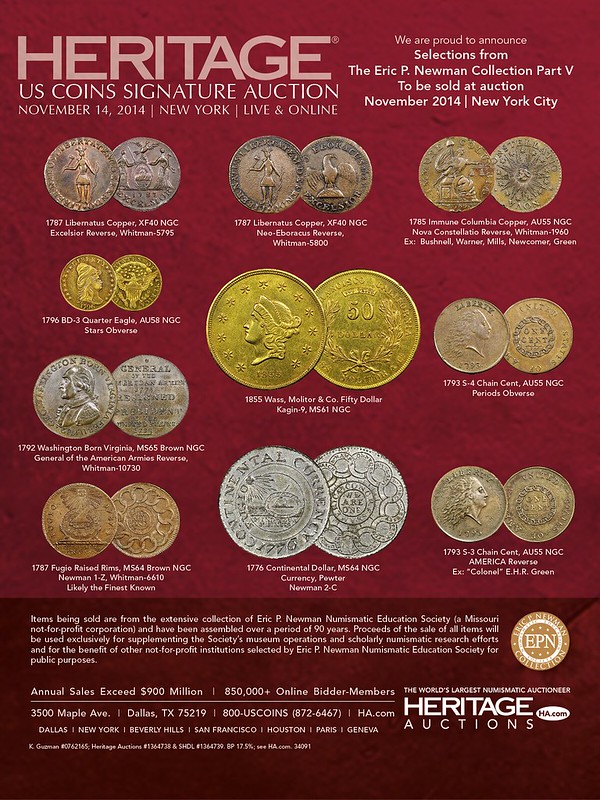
GOLD KENNEDY HALF NUMBERS DON'T ADD UP
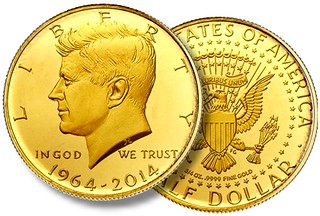 The numbers just don’t add up.
The numbers just don’t add up.
The cumulative totals of Proof 1964–2014-W Kennedy 50th Anniversary gold half dollars reported graded and encapsulated by Professional Coin Grading Service, Numismatic Guaranty Corp. and ANACS during Aug. 5 to 7 sales at the American Numismatic Association World’s Fair of Money in Rosemont, Ill., exceed the number of coins offered and reported sold by the U.S. Mint by 613 coins.
The ANA-show grading numbers, 1,136 coins for NGC, 947 coins for PCGS and 30 gold half dollars for ANACS, total 2,113 — 613 coins more than the 1,500 coins the U.S. Mint offered and sold at the show.
The discrepancy is apparently the result of coins being submitted at the ANA show for certification that likely had actually been purchased at one of the three other sales outlets offering the coins and then forwarded to the Rosemont location for grading and encapsulation. Grading services certifying coins sold at the ANA convention operated under different policies, with two requiring sales receipts showing that the coins had been sold at the show, and one firm not requiring the receipts.
The numbers discrepancies were first reported online in an Aug. 22 article by Charles Morgan on CoinWeek.com.
To read the complete Coin World article, see:
Sales
versus certified: numbers for Proof gold Kennedy 50th Anniversary half dollars don’t match
(www.coinworld.com/insights/kennedy-gold-proof-half-certification-sales-mismatch.all.html)
To read the earlier CoinWeek article, see:
The Kennedy Gold Proof Launch and the Modern Coin Market
(www.coinweek.com/coin-clubs/american-numismatic-association/kennedy-gold-proof-modern-market-numbers-add/)
JOHN LANCHESTER ON THE ORIGIN OF THE DOLLAR
Jeff Reichenberger writes:
This past weekend I heard an interview on NPR with author John Lanchester, who has written a book entitled; "How to Speak Money: What the Money People say and what it really means." Hardcover, 256 pages, W W Norton & Co Inc, List Price: $26.95
In the interview they discussed the origin of the word 'dollar' which has probably already been covered in The E-Sylum, but I thought it was interesting and have excerpt a bit of the discussion here.
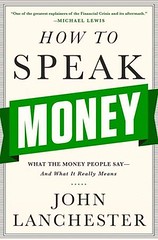 INTERVIEWER: As you flip through the book, there are all
kinds of terms defined that one would expect. But there are also some surprising terms. I'm
going to ask you to read the first one because I'm sure I would mispronounce it.
INTERVIEWER: As you flip through the book, there are all
kinds of terms defined that one would expect. But there are also some surprising terms. I'm
going to ask you to read the first one because I'm sure I would mispronounce it.
LANCHESTER: I don't know how to pronounce it either. I'm going to take a wild guess.
(Reading) Jachymov. I bet you've indirectly referred to this place in the Czech Republic at some point in the last week. If you're interested in money, you will certainly have used it at some point in the last day, maybe even in the last hour. How so? Can you guess? Give up? Well, the Bohemian town of Jachymov is known in German as Joachimsthal.
Does that help? It was the site of a famous silver mine, a town that grew tenfold in population between 1516 to 1526 as it became the center of a boom based on the manufacture of a silver coin known as joachimsthaler. It in time became known tolar or thaler.
The coins were a standard size and form of currency throughout most of Europe for 400 years. And it's from this ubiquity that we get the word dollar. So every time a dollar is mentioned, someone is unknowingly citing this otherwise obscure spot in rural Bohemia.
INTERVIEWER: So there's a term that I think might not help me read the Financial Times. But you clearly take great delight in unearthing this connection.
LANCHESTER: There's this - one of the threads in the book has to do with the oddness of money. You know, a thing that makes people go slightly nuts is when they start thinking about where does money come from? Where does its value come from? Why is it worth what it's worth?
Especially when it's digital ones and zeros, dots on the screen that seem so fragile, they seem fictional. We seem to have willed their meaning to being. And yet, the meanings are so consequential it shapes the texture of everyday life. So I'm very interested in that thing with the materiality of money.
When you can trace money back to actual stuff, it's dug out of a hole in the ground, somebody stamps an image on it, people agree what that coin with the image is worth, and then you trade with it.
And I like tracing money from those very first roots all the way through to this astonishing virtual - things like, you know, Bitcoin and things like that that also feature in the book.
To read the complete article, see:
Deciphering The 'Priestly Mumbo-Jumbo' Of The Financial World
(www.npr.org/2014/10/05/353515389/deciphering-the-priestly-mumbo-jumbo-of-the-financial-world)
THE BOOK BAZARRE
INTERVIEW WITH BERND KLUGE
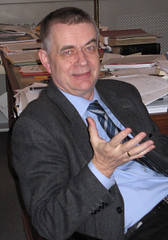 UK: Can you recall the moment you first realized that coins were
something fascinating?
UK: Can you recall the moment you first realized that coins were
something fascinating?
BK: To be honest, I only realized it when I was already employed at the Münzkabinett. Working with coins was nothing that ran in the family. Coins only became an issue to me when I tried to find a suitable job in the medieval area once I finished my studies of history at the Humboldt University Berlin. The only vacation available was at the Münzkabinett. I then came here on a trial basis, and, strictly speaking, not so much the coins made the difference but the beautiful rooms, the large doors, the library, in short the entire classy and academic atmosphere. Well, I said to myself, let’s just try this numismatics for once. That it was to become something for life was not yet apparent at the time.
UK: What did your work entail exactly? Did you first unpack the coins that had returned from Russia?
BK: The unpacking had long been done by then. What awaited us – and me, as I arrived right in the middle of it – was the toil of a general revision of the collections that had been returned from the Soviet Union in 1958. When the coin trays were being put into the drawers again it became apparent that all trays were present and accounted for but that every single one of them was in disarray. What followed then was a revision of the stock from A to Z, conducted with military precision, insofar as we systematically checked, in every cupboard and in every tray from end to end, if every single coin was lying on the right piece of paper with the correct statement of provenance. We literally examined piece after piece, which took us more than 20 years, while the challenge was to join the right coin with the right piece of paper.
UK: Had the trays been dropped in Russia?
BK: No, certainly not. The entire collection had been evacuated form the Kaiser Friedrich Museum (today Bode Museum) to the air raid shelter in the Pergamon Museum in 1942. The trays had already been bundled and tied up to form larger packages for transportation. In these packages the collection was then transported by the Red Army to St. Petersburg, which of course was called Leningrad back then, by train in 1945. Probably in order to count the coins and to do some statistical work, they were removed from the trays, but only the gold and the silver coins, to be specific. Copper and bronze were left untouched. The mess was created when the Russian noble metal counters actually turned the trays when they put the coins back in. Our trays are lying in an upright position, but the Russians had made it a landscape format to the effect that there are still the right coins on the tray, albeit the pockets they were lying in were completely wrong. To find the key to this systematic disarray and to put the coins back in the right order was the detective work of those years.
UK: Who was the first one to realize how it worked?
BK: The colleagues from ancient times were the first ones to notice. As for modern times, the situation was not that sincere because on most of the coins the date is given. These dates are likewise stated on the little sheets of paper, so that it was relatively simple to join the coins dating from 1768 with the cards stating the year 1768. As for ancient and medieval times, hardly any coin comes with a year. In some cases, it took a lot of provenance research to combine the right coin and the right card again. For example, the recording of the findspot is extremely important in the case of medieval coins, in order to resolve questions as to where and when the often silent coins had been produced, as can be seen with the bracteates. Sometimes the task was such a difficult one that we had to spend an entire day on one single tray.
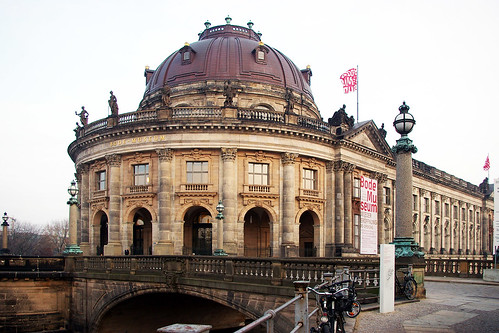
The Bode-Museum Building
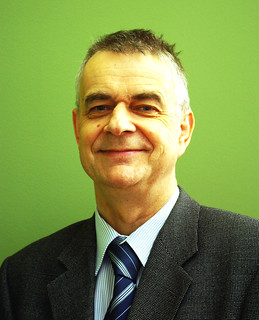
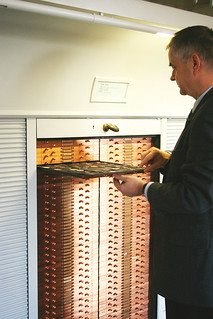
Dr. Kluge; Dr. Kluge Examining Coin Tray
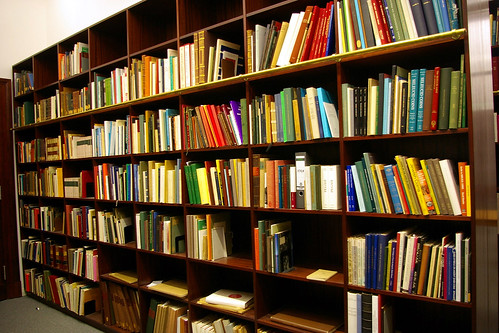
The Bode-Museum Numismatic Library
For information on Howard's book, see:
NEW BOOK: THE NUMISMATOURIST
(www.coinbooks.org/esylum_v17n31a03.html)
To read the complete article, see:
GDR – Turnaround – Reunification:
Museum and Numismatics in Politically Turbulent Times
(www.coinsweekly.com/en/News/4?&id=3052)
SOME MORE MODERN HOBO NICKELS
Waiting on the 503
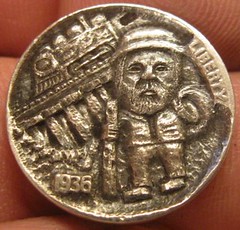
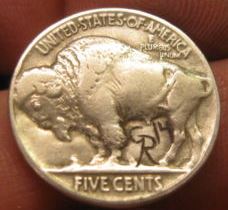
To read the complete eBay description, see:
Hobo Nickel, Waiting
on the 503 (www.ebay.com/itm/Hobo-Nickel-Waiting-on-the-503-/191357328136)
Fly in My Soup

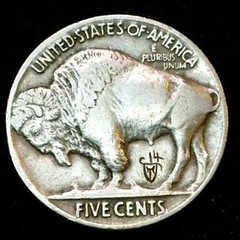
To read the complete eBay description, see:
Hobo Nickel "There's A Fly In My Soup" Chef Cat Kitten by Howard Thomas
(www.ebay.com/itm/Hobo-Nickel-Theres-A-Fly-In-My-Soup-Chef-Cat-Kitten-by-Howard-Thomas-/201186315836)
Sailor Jerry Pinup Show Girl
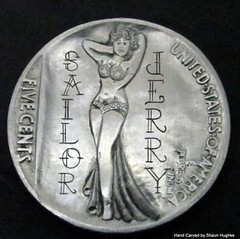
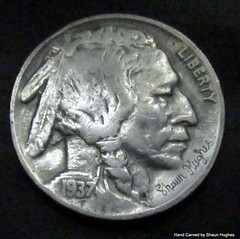
To read the complete eBay description, see:
Sailor Jerry Pinup Show Girl Tattoo Design Hobo
Nickel Carving by Shaun Hughes (www.ebay.com/itm/-/121451163523)
The Professor
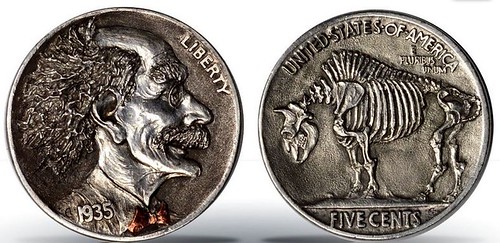
To read the complete eBay description, see:
1935 "The Professor" Hobo Nickel carving
by Aleksey Saburov (www.ebay.com/itm/-/111475670450)
To read the earlier E-Sylum article, see:
SOME MODERN HOBO NICKELS (AND DOLLARS)
(www.coinbooks.org/esylum_v17n41a08.html)
Fred Michaleson's 3-Legged Buffalo
Fred Michaelson writes:
I recently bought a 3-legged Buffalo Nickel, and I've been studying it to see whether it's genuine. One of the diagnostics, as you probably know, is that due to the damaged and poorly repaired die, the buffalo appears to be urinating. Do you think this piece passes muster in that regard?
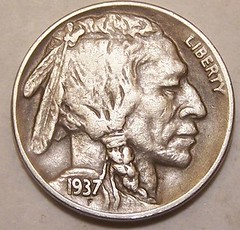
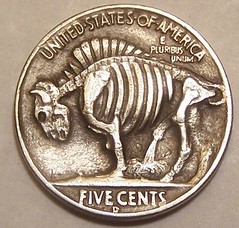
THE STUDIO OF ALEKSEY SABUROV
Ron Pope writes:
Anyone interested in seeing more of the fabulous work of Aleksey Saburov-the artist who created the Morgan dollar pictured in the last issue can go to his website to see more.
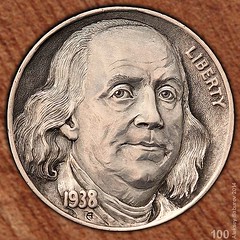
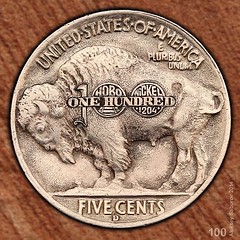
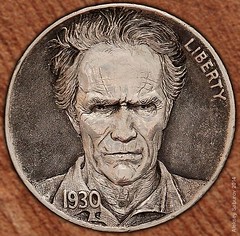
To visit the Aleksey Saburov web site , see:
http://www.saburovart.com/-to
To read the earlier E-Sylum article, see:
SOME MODERN HOBO NICKELS (AND DOLLARS)
(www.coinbooks.org/esylum_v17n41a08.html)

QUERY: THE COOK ISLANDS POP-UP COIN
Yossi Dotan writes:
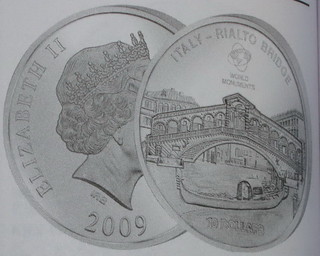 In Krause's Standard Catalog of
World Coins I found the attached image of a coin of the Cook Islands depicting the Rialto
Bridge in Venice, Italy (KM#695, 10 dollars 2009, with gilt pop-up). Other coins in this series
show other famous monuments as gilt pop-ups.
In Krause's Standard Catalog of
World Coins I found the attached image of a coin of the Cook Islands depicting the Rialto
Bridge in Venice, Italy (KM#695, 10 dollars 2009, with gilt pop-up). Other coins in this series
show other famous monuments as gilt pop-ups.
I wonder whether E-Sylum readers can help me understand the pop-up mechanism.
Probably the coin is composed of two matching pieces of metal, a silver round and a gilt bridge, and the miniature bridge can be taken out of the silver round and placed upright. Is there a slot embedded in the silver round under the bridge into which the bridge has to be inserted to have it stand upright? Or is there a hinge that connects the bridge to the coin?
Many thanks for any information readers can give!
THE MAKING OF PORTUGAL'S ECCENTRIC COIN
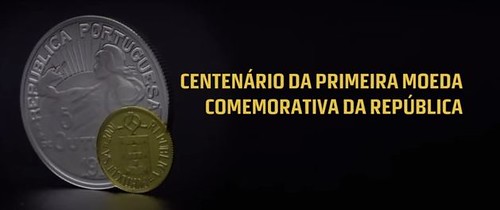
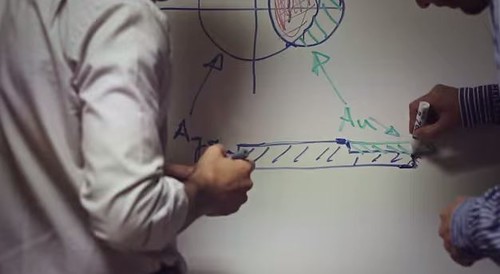
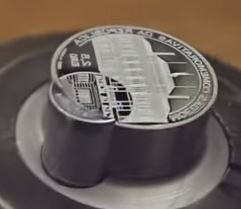


To watch the video (in Portuguese), see:
Moeda excêntrica - Centenário da Primeira
Moeda Comemorativa da República (www.youtube.com/watch?v=_SomikZJt4E)
To read the earlier E-Sylum article, see:
WORLD'S FIRST ECCENTRIC BIMETALLIC
COIN (www.coinbooks.org/esylum_v17n38a29.html)
THE BOOK BAZARRE
NORWAY'S NEW PIXEL BANKNOTES
Believe it or not, this is Norway’s new currency design, set to be released in 2017. The backsides of their controversial new banknotes feature color palettes that look like digitally blurred versions of the images found on the fronts of the bills.
Both sides of the bills were selected by Norges Bank during a competition held in the spring of 2014. The front side contains a series of artwork by graphic design studio The Metric System and Terje Tønnessen called “Norwegian Living Space,” while the pixelated back features a series called “Ripple Effects” by Enzo Finger. The front features various ocean scenes of importance to the Norwegian national identity.
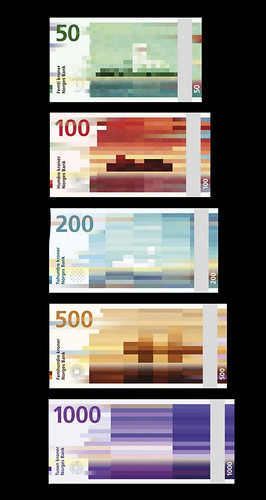
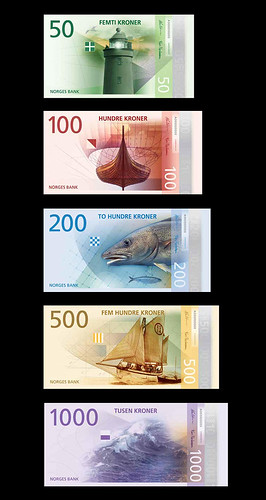
To read the complete article, see:
This Is What
Norway’s Money Will Look Like In 2017
(www.boredpanda.com/new-norwegian-banknotes-pixel-bills-design/)
Norges Bank has announced that designs by two Oslo studios have been chosen to feature on Norway's new banknotes, which will come into circulation in 2017. Snøhetta's design for the reverse of the notes features a pixellated image of the country's coastline, the amount of distortion depicting the wind speed as it whips up with each denomination...
Earlier this year, eight designers were invited to submit proposals for Norway's new banknote design on the theme of 'the sea'. Today, the central bank of Norway announced that designs by The Metric System and Snøhetta will be used on the obverse (full set shown bottom of post) and reverse sides of the banknotes, respectively.
Snøhetta's design, 'Beauty of Boundaries', renders images from the Norwegian coastal landscape in a mosaic-like pixellated form. Using a modern visual langauge, say the studio, they aimed to respresent where the sea and land meet, reflecting the communities which thrive on the coast.
According to the Norges Bank catalogue accompanying an exhibition of the shortlisted work, the patterns generated on the studio's designs for the reverse refer to the Beaufort wind force scale. On the 50 kroner denomination the wind is weak, so the image is rendered in short, square shapes; while on the 1,000 kroner note the wind is strong, creating longer, stretched-out forms and – while difficult to discern in the images shown here – choppier waves in the water.
It's such a refreshing idea and reminded us of the kind of attention to detail on show in the work of the great 'Ootje' Oxenaar, who designed the Dutch banknotes in the late 1960s – and often included 'personal' touches in the designs, to the annoyance of the Dutch Central Bank.

To read the complete article, see:
Norway's
new banknotes influenced by the sea air
(www.creativereview.co.uk/cr-blog/2014/october/norway-banknote-design-pixellated-snohetta)

THE FUTURE OF THE BOOK: CHAPTER ONE
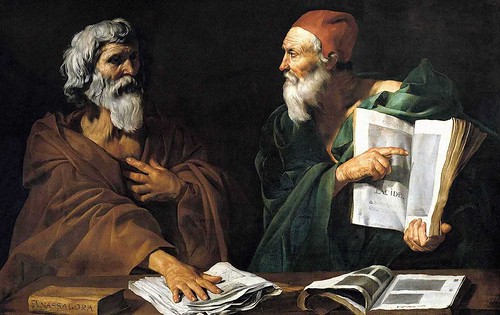
FINGERS stroke vellum; the calfskin pages are smooth, like paper, but richer, almost oily. The black print is crisp, and every Latin sentence starts with a lush red letter. One of the book’s early owners has drawn a hand and index finger which points, like an arrow, to passages worth remembering.
In 44BC Cicero, the Roman Republic’s great orator, wrote a book for his son Marcus called de Officiis (“On Duties”). It told him how to live a moral life, how to balance virtue with self-interest, how to have an impact. Not all his words were new. De Officiis draws on the views of various Greek philosophers whose works Cicero could consult in his library, most of which have since been lost. Cicero’s, though, remain. De Officiis was read and studied throughout the rise of the Roman Empire and survived the subsequent fall. It shaped the thought of Renaissance thinkers like Erasmus; centuries later still it inspired Voltaire. “No one will ever write anything more wise,” he said.
The book’s words have not changed; their vessel, though, has gone through relentless reincarnation and metamorphosis. Cicero probably dictated de Officiis to his freed slave, Tiro, who copied it down on a papyrus scroll from which other copies were made in turn. Within a few centuries some versions were transferred from scrolls into bound books, or codices. A thousand years later monks meticulously made copies by hand, averaging only a few pages a day. Then, in the 15th century, de Officiis was copied by a machine. The lush edition in your correspondent’s hands—delightfully, and surprisingly, no gloves are needed to handle it—is one of the very first such copies. It was printed in Mainz, Germany, on a printing press owned by Johann Fust, an early partner of Johannes Gutenberg, the pioneer of European printing. It is dated 1466.
Some 500 years after it was printed, this beautiful volume sits in the Huntington Library in San Marino, California, its home since 1916. Few physical volumes survive five centuries. This one should last several more. The vault that holds it and tens of thousands of other volumes, built in 1951, was originally meant to double as a nuclear-bomb shelter.
Although this copy of de Officiis may be sequestered, the book itself is freer than ever. In its printed forms it has been a hardback and, more recently, a paperback, published in all sorts of editions—as a one off, a component of uniform library editions, a classic pitched at an affordable price, a scholarly, annotated text that only universities buy. And now it is available in all sorts of non-printed forms, too. You can read it free online or download it as an e-book in English, Latin and any number of other tongues.
Many are worried about what such technology means for books, with big bookshops closing, new devices spreading, novice authors flooding the market and an online behemoth known as Amazon growing ever more powerful. Their anxieties cannot simply be written off as predictable technophobia. The digital transition may well change the way books are written, sold and read more than any development in their history, and that will not be to everyone’s advantage. Veterans and revolutionaries alike may go bust; Gutenberg died almost penniless, having lost control of his press to Fust and other creditors.
But to see technology purely as a threat to books risks missing a key point. Books are not just “tree flakes encased in dead cow”, as a scholar once wryly put it. They are a technology in their own right, one developed and used for the refinement and advancement of thought. And this technology is a powerful, long-lived and adaptable one.
Books like de Officiis have not merely weathered history; they have helped shape it. The ability they offer to preserve, transmit and develop ideas was taken to another level by Gutenberg and his colleagues. Being able to study printed material at the same time as others studied it and to exchange ideas about it sparked the Reformation; it was central to the Enlightenment and the rise of science. No army has accomplished more than printed textbooks have; no prince or priest has mattered as much as “On the Origin of Species”; no coercion has changed the hearts and minds of men and women as much as the first folio of Shakespeare’s plays.
Books read in electronic form will boast the same power and some new ones to boot. The printed book is an excellent means of channelling information from writer to reader; the e-book can send information back as well. Teachers will be able to learn of a pupil’s progress and questions; publishers will be able to see which books are gulped down, which sipped slowly. Already readers can see what other readers have thought worthy of note, and seek out like-minded people for further discussion of what they have read. The private joys of the book will remain; new public pleasures are there to be added. What is the future of the book? It is much brighter than people think.
To read the complete article, see:
ESSAY
• THE FUTURE OF THE BOOK
(www.economist.com/news/essays/21623373-which-something-old-and-powerful-encountered-vault)
THE FUTURE OF NUMISMATICS
Expanding the hobby is the point of this article. Whenever possible, I try to stress the importance of this issue for the future of numismatics. Regardless of what you collect, the hope is that when you decide to sell, there will be new collectors eager to purchase your material. This is only possible by attracting and retaining new collectors to numismatics each year. Every hobby organization in the country is facing the problem of competing for attention in a world now dominated by social media, endless entertainment options, and less and less leisure time. Rare coins have a lot to offer, but it’s sometimes hard to get the message out. Many dealerships have embraced new media to expand their business. Facebook, Twitter, Google, eBay and many others are now common tools of the trade of numismatics.
Another incredibly important aspect of growing the future of numismatics is to encourage young people interested in numismatics as a career. Numismatic education is vitally important for those wanting to be a coin dealer. The Summer Seminar is one of the most successful programs the ANA offers each year. Hundreds of individuals travel to Colorado Springs every summer for these classes. Many of them are young numismatists who have earned scholarships. Dozens have gone on to successful numismatic careers, and some now actually teach classes. NGC generously donates the time of several grading experts for these classes every year. These are very popular classes, and they usually sell out quickly.
Another interesting development that has been started in the last few years is the idea of creating apprenticeship opportunities. NGC offers promising rare coin graders the chance to work alongside some of the best in the business. They are provided free lodging, transportation, expenses, and invaluable encouragement. The Professional Numismatic Guild (PNG) recently launched a similar program for those interested in a numismatic career. Participants work for three months at four different companies over the course of a year. Companies may offer and have offered permanent employment to those who demonstrate exceptional skill. Programs like these can make a huge difference for anyone looking to get their foot in the door. Locally, I have a 16-year-old young man that has declared his intentions to be a rare coin dealer. He works in my office learning as much as possible about the world of rare coins. It is very exciting to see a new generation taking such a keen interest in the hobby we all love so much.
In 2015, the Smithsonian Institution’s National Museum of American History will debut its new, 1,000 square foot, numismatic exhibit. The new exhibit has been years in the planning and promises to be a wonderful opportunity to expand interest in numismatics. The new exhibit was made possible by the amazing support of many generous donors, including NGC. I have been working behind the scenes with the numismatic department to create material that can be given away to those visiting the exhibit. Plans are underway to develop a numismatic discovery cart with volunteers offering educational narrative and brochures about coin collecting. Over four million people visit the National Museum of American History each year. Years ago, I was inspired by US gold coins when viewing the amazing Lilly collection that had been on exhibit in the numismatic gallery. Hopefully, the new exhibit will inspire a new generation of collectors.
To read the complete article, see:
The Future Of Numismatics
(www.coinweek.com/education/future-numismatics/)

THE YEAR OF FIVE EMPERORS
By the end of 192 CE, it was clear to everyone in Rome that emperor Commodus was dangerously insane. Plots began to form. His favorite concubine, Marcia, slipped poison into his wine but he threw it up. Plan B: a wrestler named Narcissus strangled him. The next morning (New Year’s Day, 193), the Praetorian Guard proclaimed Pertinax, the elderly city manager (praefectus urbi) as emperor. The Senate joyfully confirmed him and declared the dead Commodus a public enemy, revoking his decrees and tearing down his statues.
So began the Year of Five Emperors, a chaotic period that would keep the coin die engravers at Roman mints very busy indeed. Some of the rarest Roman coins were struck during the next few months, along with many available to collectors today at surprisingly modest cost.
Pertinax
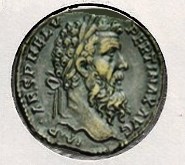 Most historians agree Pertinax was implicated in the death of
Commodus, but he probably saw this as a last resort to save Rome, not as a personal power grab.
Most historians agree Pertinax was implicated in the death of
Commodus, but he probably saw this as a last resort to save Rome, not as a personal power grab.
Considering that he ruled for just 87 days, his coinage is remarkable: six issues of gold, 11 of silver and 14 in bronze or copper at Rome, and several at Alexandria including rare types honoring his young wife Titiana and son Pertinax Junior. He raised the silver content of the denarius from 74% to 87%. His powerful, bearded portrait conveys a sense of gravitas – that untranslatable Latin term that combines seriousness, authority, and the power to command respect.
It wasn’t enough to prevent his overthrow, however. On March 28, Pertinax tried to quell a mutiny of the unruly Praetorian Guard. He was killed by a javelin to the chest.
Didius Julianus
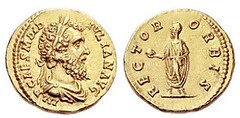 He may have been implicated in the mutiny that led to
the death of Pertinax; sources uniformly treat him as a scoundrel and a coward. Julianus wasted no
time in issuing coins promoting his imperial reign and honoring his wife, Manlia Scantilla, and
daughter, Didia Clara. On one reverse, he holds a globe and proclaims himself RECTOR ORBIS –
“master of the world.” Nervous about the loyalty of his troops, his most common reverse type is
CONCORDIA MILITUM – “Consent of the Army.” As his enemies closed in, Julianus grew desperate.
Attempting to conciliate his main rival, he added the name “Severus” to his own nomenclature on the
coinage, even as he dispatched assassins (unsuccessfully) to kill him. Held in contempt by the
senate and people of Rome, Julian us "…was conducted into a private apartment of the baths of
the palace, and beheaded as a common criminal..."
He may have been implicated in the mutiny that led to
the death of Pertinax; sources uniformly treat him as a scoundrel and a coward. Julianus wasted no
time in issuing coins promoting his imperial reign and honoring his wife, Manlia Scantilla, and
daughter, Didia Clara. On one reverse, he holds a globe and proclaims himself RECTOR ORBIS –
“master of the world.” Nervous about the loyalty of his troops, his most common reverse type is
CONCORDIA MILITUM – “Consent of the Army.” As his enemies closed in, Julianus grew desperate.
Attempting to conciliate his main rival, he added the name “Severus” to his own nomenclature on the
coinage, even as he dispatched assassins (unsuccessfully) to kill him. Held in contempt by the
senate and people of Rome, Julian us "…was conducted into a private apartment of the baths of
the palace, and beheaded as a common criminal..."
Pescennius Niger
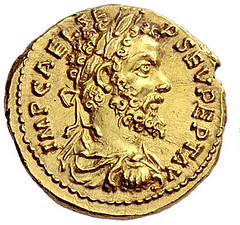 Born in Italy c.135 – 140 CE, Gaius Pescennius Niger
rose to the rank of consul in 190. Commodus appointed him governor of Syria in 191. His unusual
cognomen, or nickname, means “black”, and is supposedly based on the fact that he had very
dark skin on his neck. When news of the murder of Pertinax arrived, nine legions in the East
proclaimed him emperor*.
Born in Italy c.135 – 140 CE, Gaius Pescennius Niger
rose to the rank of consul in 190. Commodus appointed him governor of Syria in 191. His unusual
cognomen, or nickname, means “black”, and is supposedly based on the fact that he had very
dark skin on his neck. When news of the murder of Pertinax arrived, nine legions in the East
proclaimed him emperor*.
His coinage was struck at Antioch in Syria, Alexandria in Egypt, and Caesarea in Cappadocia (“Caesarea” was a popular Roman place name; like “Springfield” in the USA). Issued in haste to pay the troops, the coins often have blundered inscriptions and crude workmanship. But some are impressive, like the rare debased silver tetradrachm of Antioch.
Clodius Albinus
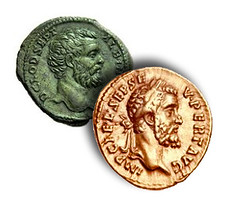 Decimus Clodius
Septimius Albinus, whose cognomen refers to his extremely light complexion, was born about 140 CE
at Hadrumetum, in Tunisia. He rose to the rank of consul in 187 and was appointed governor of
Britain by Commodus. After Septimius Severus was proclaimed emperor by his legions in April, 193,
he quickly offered Albinus the empty title of “Caesar” (in theory the emperor’s designated
successor).
Decimus Clodius
Septimius Albinus, whose cognomen refers to his extremely light complexion, was born about 140 CE
at Hadrumetum, in Tunisia. He rose to the rank of consul in 187 and was appointed governor of
Britain by Commodus. After Septimius Severus was proclaimed emperor by his legions in April, 193,
he quickly offered Albinus the empty title of “Caesar” (in theory the emperor’s designated
successor).
Severus issued coins at Rome in the name of Albinus as Caesar, but the portrait is similar to that of Severus himself, and the engravers might have lacked a realistic image to work from. Coinage in the name of Albinus as Caesar included at least five types in gold (very rare), seven in silver, and 10 in bronze.
Defeated in a great battle near Lugdunum, he killed himself to avoid capture.
Septimius Severus
When news of the murder of Pertinax arrived, the three legions based at his headquarters in the
town of Carnuntum acclaimed Severus as emperor. He immediately marched on Rome, made short work of
Didius Julianus, and disbanded the treacherous Praetorians after executing the men who killed
Pertinax. He then added “Pertinax” to his own name, to honor the former emperor’s memory (elite
Romans seem to have changed their names about as often as they changed their togas).
The coinage of Severus’ 18-year reign is vast in quantity and variety, but his initial issues from 193 include a handsome “Victory” aureus and a series of denarii to honor–and to pay–the 16 legions that eventually supported him.
To read the complete article, see:
193: The Year of Five
Emperors (www.coinweek.com/featured-news/193-year-five-emperors/)
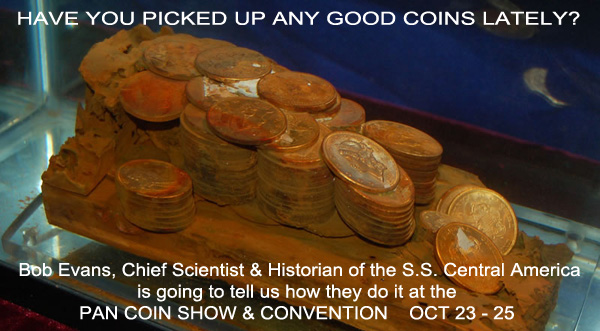
SELECTIONS FROM THE STACK'S BOWERS 2014 BALTIMORE SALE
Choctaw Treasury Warrant

Armstrong Academy, Indian Territory. National Treasurer of the Choctaw Nation. March 1, 1863 Reissued 1865. $5 Choctaw Treasury Warrant. About Very Fine. Very Rare Choctaw Nation Reissued 1865 $5 Note
(Haxby-Not listed; Shull Cr.CHOC04, listed as Rarity-10; Burgett-4). Uniface. Printed on ‘’peach or pink’’ rag paper. Typeset within plain frame lines. Left end with floral repeating pattern. Similar to 1987 Ball-Richmond Sale: Lot 1098. The type not in Ford XX (had an example that was not reissued. Serial 52, Series 1. Written issuance and back countersigned by Allen Wright and reissued in 1865 with 5% interest. Rarer reissued type from the Act of 1865, Shull estimates 5-15 known. A great rarity reissued and not in Ford’s Collection. The Shull rarity rating might be conservative and considered the second rarest denomination from the series.
Some perspective is in order about evaluating the very rare and historic Confederate era notes. At the time of the Ball-Richmond Sale in 1987, notes from this series were estimated in $1,000-$2,000 range at a time when rare proofs were estimated $200-$300. Nowadays, those proofs routinely sell for five to ten times those seemingly ancient days. We have always considered the Confederate era Indian Territory rarities to be undervalued. Many of the greatest paper money collectors of all time greatly appreciated them such as Amon Carter, the Schingoethe’s, Maurice Burgett, Eric Newman, and others.
To view the complete lot description, see:
Armstrong Academy, Indian Territory (www.stacksbowers.com/BrowseAuctions/LotDetail/tabid/227/
AuctionID/6039/Lot/2202/Default.aspx)
Beazell United States Counterfeit Detector
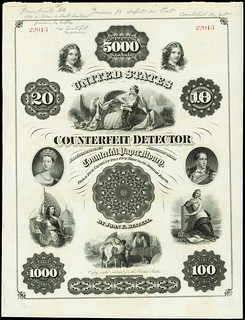
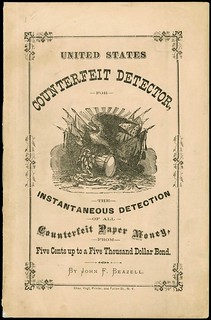
John F. Beazell United States Counterfeit Detector. 1867. Vignette Broadside by Continental Bank Note Co. and Original Book. Very Fine.
A significant and handsome pairing of security printing history pieces featuring superb Continental Bank Note Company vignettes engraved and printed to a uniface broadside, but with the original accompanying book by John F. Beazell. The book is much rarer than the large quarto detection broadside and first we have catalogued.
The pair includes; 1) Intaglio printed and titled broadside which was once tipped into an original book. 220mm by 320mm. Full titles and imprint. Four vignettes, four portraits, and seven dies or counters. Numbered 22013. Choice Very Fine with pencil notations at the upper left. 2) 1867 John F. Beazell original book ‘’UNITED STATES COUNTERFEIT DETECTOR –THE INSTANTANEOUS DETECTION OF ALL COUNTERFEIT PAPER MONEY, FROM Five cents Up to Five Thousand Dollar Bond’’. Octavo. Tan paper with vignette of eagle and drum. 16pp.
To view the complete lot description, see:
John F. Beazell United States Counterfeit Detector. 1867
(www.stacksbowers.com/BrowseAuctions/LotDetail/tabid/227/
AuctionID/6039/Lot/2232/Default.aspx)
1891 $1000 Silver Certificate

Fr. 346e Type. 1891 $1000 Silver Certificate. Face Proof. PCGS Choice About New 58. Illustrious $1,000 "Marcy" Silver Certificate Design
No plate letter. Printed on India paper, mounted on card stock. Imprint of the Bureau of Engraving and Printing lower left border. Black and white portions of the face only. Center, extremely intricate titles with ornate “S” within larger circular die, below the written denomination within a guilloche. Left end, Peace cradles sword to her chest with 1000 counter on shield. Right end, different portrait of Wm. L. Marcy than used on the 1878/1880 series within a panel. Engraved signatures. Very similar to Hessler 1411, page 95.
A stunning execution of Federal currency engraving. When this face plate was used for a modern BEP souvenir card, it was very well received. There are only two known issued notes of the type with the one collectible example being sold privately by us for $2.6 million. We are uncertain of the pedigree of the Hessler Plate note, but we presume this face proof is exceedingly rare. We sold another proof example on wide margin paper with perforations that brought an impressive $111,625 as lot 2201 in our August 2014 ANA sale. An exceptional showpiece and a design that will likely never see the auction block in issued form in a lifetime.
To view the complete lot description, see:
Fr. 346e Type. 1891 $1000 Silver Certificate
(www.stacksbowers.com/BrowseAuctions/LotDetail/tabid/227/
AuctionID/6039/Lot/2390/Default.aspx)
1922 $1000 Gold Certificate

Fr. 1220. 1922 $1000 Gold Certificate. PMG Very Fine 25 Net. Repaired, Small Tears. Scarce 1922 $1,000 Gold Certificate
This stunning design shows a portrait vignette of Hamilton at center, gold overprints at left and right, with "$1,000" under-print at left and Treasury seal at right.
To view the complete lot description, see:
Fr. 1220. 1922 $1000 Gold Certificate.
(www.stacksbowers.com/BrowseAuctions/LotDetail/tabid/227/
AuctionID/6039/Lot/2444/Default.aspx)
1981 $100 Federal Reserve Star Note. Richmond
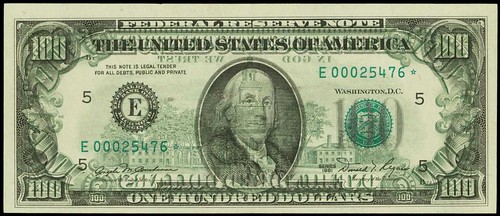
Fr. 2169-E*. 1981 $100 Federal Reserve Star Note. Richmond. PMG Choice About Uncirculated 58 Net. Offset Printing Error. An impressive full back to front offset error is displayed on this lightly handled $100 Replacement Note. The offset is quite bold with deep green color displayed on the face.
To view the complete lot description, see:
Fr. 2169-E*. 1981 $100 Federal Reserve Star Note. Richmond
(www.stacksbowers.com/BrowseAuctions/LotDetail/tabid/227/
AuctionID/6039/Lot/2600/Default.aspx)
City of Albany. 50 Cents. April 17, 1815
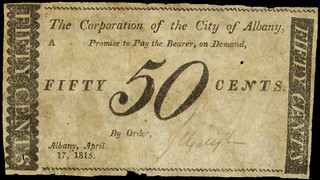
Albany, New York. City of Albany. 50 Cents. April 17, 1815. Fine. Harris 72. No imprint. "FIFTY CENTS" in left and right panels. Large 50 at center. Black print. Rarity 7 in Harris. Solid paper for the grade. Minor damage in bottom margin. Seen just a few times over the last 10 years or so.
To view the complete lot description, see:
Albany, New York. City of Albany. 50 Cents. April 17, 1815
(www.stacksbowers.com/BrowseAuctions/LotDetail/tabid/227/
Lot/13169/AuctionID/6039/Default.aspx)
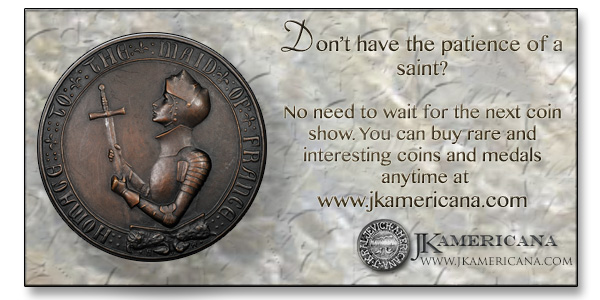
SOME RECENT COIN DESIGNS
French 10 Euro Coin on Molière's Play L'avare
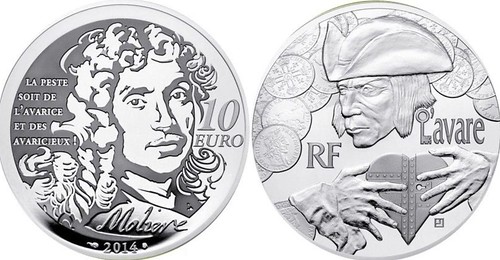
This French 10 Euro coin honors Molière's play L'avare (The Miser).
French 10 Euro Coin on Voltaire's Novel Candide
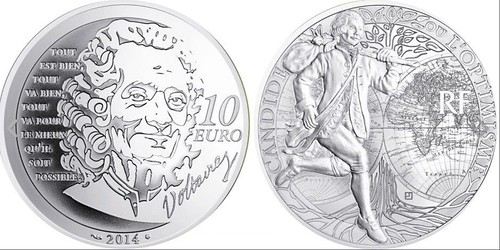
This French 10 Euro coin honors Voltaire's Candide. With both of these coins, the reverse is in a more classic style, while the obverse portraits are less detailed and make use of negative space. Interesting combination.
Finland 10 Euro coin on sculptor Emil Wikstrom
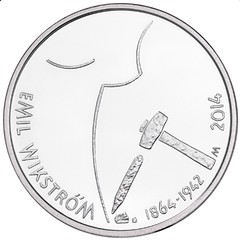
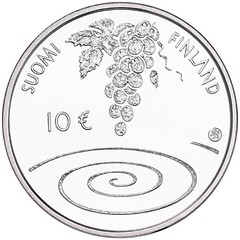
This commemorative coin on sculptor Emil Wikstrom takes the minimalist route. That doesn't always work on a coin, but I think it does here.
Belgium 20 Euro on Berlin Wall

Has it been 25 years already? This Belgian piece commemorates the 25th anniversary of the fall of the Berlin wall. It's an important topic for commemoration. I'm not sure I could have come up with anything better, but this design doesn't move me. I think it’s the absence of people. The real drama of the event was the freeing of an imprisoned people.
Two America the Beautiful Quarters
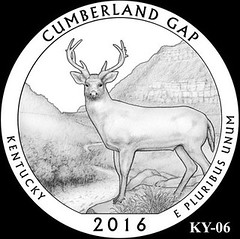
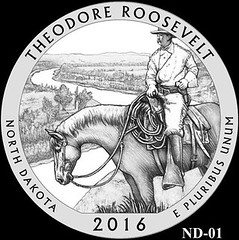
Thanks to Pabitra for sending all the new coin designs. Here are two from another source. Coin Update , where Michael Zielinski published an article on October 7, 2014 about recent design candidate selections by the Commission of Fine Arts (CFA) for the 2016 America the Beautiful Quarters series.
To read the complete article, see:
CFA
Recommendations for 2016 America the Beautiful Quarters
(news.coinupdate.com/cfa-recommendations-for-america-the-beautiful-quarters-4508/)
COUNTRIES THAT DON’T ISSUE THEIR OWN CURRENCY
Countries that only use a foreign currency
US dollar: Ecuador, East Timor, El Salvador, Marshall Islands, Micronesia, Palau, Turks and Caicos, British Virgin Islands, Zimbabwe.
The US dollar is the most widely used currency in the world, with many countries employing it as an accepted alternative to their own currency. But some have simply adopted the currency as their own, notes and all, in what is known as “dollarization.” They don’t have control over the currency—only the Federal Reserve in Washington sets monetary policy. Both Ecuador and El Salvador adopted the US dollar in 2000, following the creation of free-trade blocs like NAFTA and the EU and the debut of the euro, making even the notion of a “single currency for the hemisphere more plausible and attractive.”
Countries in a currency union
Euro: Austria, Belgium, Cyprus, Estonia, Finland, France, Germany, Greece, Ireland, Italy, Latvia, Luxembourg, Malta, the Netherlands, Portugal, Slovakia, Slovenia, and Spain.
Calls for monetary union in Europe date back to the 1920s, but things got serious when the European Commission (of the European Economic Community, precursor to the European Union) began looking into ways to stabilize fluctuations between the their currencies in the late 1960s. In 1989, the path to monetary union was set out in the Delors report. In 1992, the Maastricht Treaty was signed, which created the EU and set up the path to the launch of the euro in 1999. In 2002, euro notes and coins entered circulation.
There are extensive criteria to join the euro, but nothing in the EU treaties about leaving it—which was unfortunate, as many countries’ finances came under severe strain in the aftermath of the 2008 financial crisis. (None more so than Greece, which at one pointed owed $250,000 for each working adult.) While the euro looked doomed for awhile, the problem was solved using one of the best traditions of capitalism: throwing more debt at the problem. Greece was bailed out—twice—and there was one bailout each for Portugal, Ireland, and Cyprus by the euro zone countries and the IMF. Spain’s banks were bailed out, too, and a 500 billion-euro fund was set up to permanently act as a firewall to prevent this from happening again.
Alternatively…
Many places both officially and unofficially allow the trade of foreign currencies alongside their own. Residents from Belize to North Korea can spend in US dollars, for example. Panama has had the US dollar as legal tender since 1904, alongside the Panamanian balboa, and was viewed as a special case in Latin America because of the Panama Canal and its huge trade links with the world’s richest country. Others are usually based on relative economic might and regional proximities; Lesotho and Namibia also use South Africa’s rand and small islands like Tuvalu and Nauru use Australian dollars.
To read the complete article, see:
Here are all
the countries that don’t have a currency of their own
(qz.com/260980/meet-the-countries-that-dont-use-their-own-currency/)
THE BOOK BAZARRE
FEATURED WEB PAGE: THE COINS OF ECUADOR
This week's Featured Web Page is a CoinWeek article by Carlos Jara on Collecting The Coins of Ecuador.The coins of Ecuador have traditionally been both respected as difficult to obtain, and very popular among collectors. While not a particularly extensive series (as opposed to, say, Colombia), the Ecuadorean series is complex nonetheless. Thankfully, good references about it have been available for a long time. For example, Dale Seppa’s checklists are a great and inexpensive starting point. Years ago, the more serious collector had to search for a copy of Ortuno’s ” Historia Numismatica de Ecuador “, which is not that easy to find.

www.coinweek.com/featured-news/collecting-coins-ecuador/

